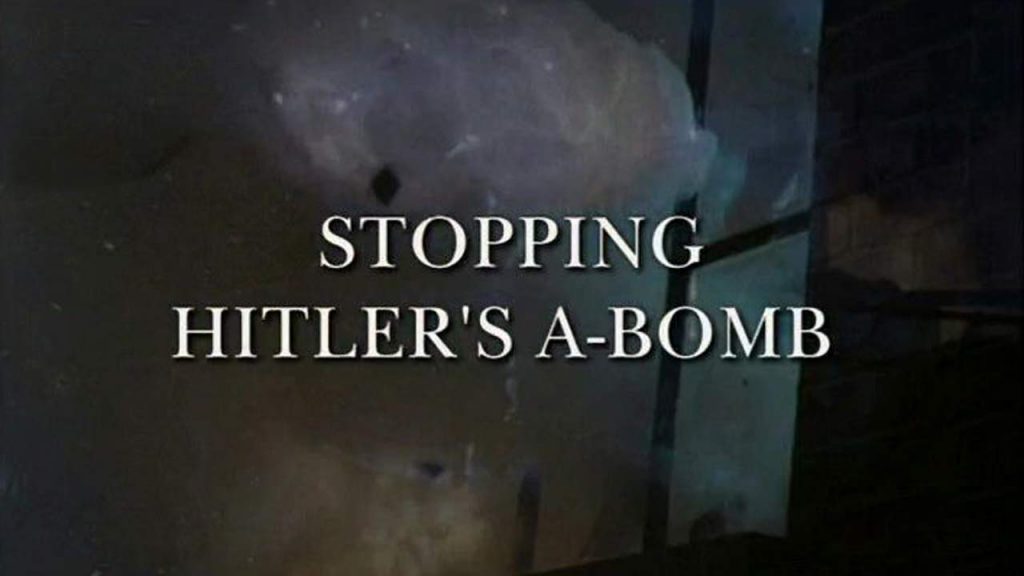Great Raids of World War II episode 1: It was Hitler’s deadliest secret – his scientists had promised him an atomic bomb. If he got it first, Nazi domination was assured. But the Germans needed one ingredient – heavy water – which was only produced in one factory – deep in the heart of occupied Norway. In 1943 a team of Norwegian raiders was sent to destroy it – their success or failure could decide the outcome of the war.
World War II was the greatest military confrontation the world has ever known. On land and sea and in the air the scale of the conflict was unprecedented. But amid the great campaigns were many smaller-scale operations which were vital to Allied success – occasions when small numbers of men could have an effect out of all proportion to their numbers; occasions when the course of the war hinged on their courage and daring.
This series looks at six such raids. With the use of veterans’ accounts; carefully researched archive film; meticulous reconstructions and 3-D graphics the viewer is put right into the heart of the action – whether it was foiling Hitler’s attempts to acquire an atomic bomb, or discovering the secrets of the air defences of the Nazi Reich. The recreated raids include the British and Norwegian mission to smash Hitler’s nuclear programme; the canoe-borne commando assault on Bordeaux to disrupt supplies of raw materials essential for Hitler’s war machine; and the paratroop capture of a key German radar installation at Bruneval, which brought back information vital to enable Britain’s bombers to strike at the heart of Nazi Germany. All six episodes from the series are included on this set.
Great Raids of World War II episode 1 – Stopping Hitler’s A-Bomb
German nuclear weapons program
The Uranverein (English: “Uranium Club”) or Uranprojekt (English: “Uranium Project”) was the name given to the project in Germany to research nuclear technology, including nuclear weapons and nuclear reactors, during World War II. It went through several phases of work, but in the words of historian Mark Walker, it was ultimately “frozen at the laboratory level” with the “modest goal” to “build a nuclear reactor which could sustain a nuclear fission chain reaction for a significant amount of time and to achieve the complete separation of at least tiny amount of the uranium isotopes.” The scholarly consensus is that it failed to achieve these goals, and that despite fears at the time, the Germans had never been close to producing nuclear weapons.
The first effort started in April 1939, just months after the discovery of nuclear fission in December 1938, but ended only months later shortly ahead of the German invasion of Poland, when many notable physicists were drafted into the Wehrmacht.
A second effort began under the administrative purview of the Wehrmacht’s Heereswaffenamt on 1 September 1939, the day of the invasion of Poland. The program eventually expanded into three main efforts: the Uranmaschine (nuclear reactor), uranium and heavy water production, and uranium isotope separation. Eventually, it was assessed that nuclear fission would not contribute significantly to ending the war, and in January 1942, the Heereswaffenamt turned the program over to the Reich Research Council (Reichsforschungsrat) while continuing to fund the program. The program was split up among nine major institutes where the directors dominated the research and set their own objectives. Subsequently, the number of scientists working on applied nuclear fission began to diminish, with many applying their talents to more pressing war-time demands.
Nazi Germany
Nazi Germany (officially known as the German Reich from 1933 until 1943, and the Greater German Reich from 1943 to 1945) was the German state between 1933 and 1945, when Adolf Hitler and the Nazi Party controlled the country, transforming it into a dictatorship. Under Hitler’s rule, Germany quickly became a totalitarian state where nearly all aspects of life were controlled by the government. The Third Reich, meaning “Third Realm” or “Third Empire”, alluded to the Nazi claim that Nazi Germany was the successor to the earlier Holy Roman Empire (800–1806) and German Empire (1871–1918). The Third Reich, which Hitler and the Nazis referred to as the Thousand-Year Reich, ended in May 1945 after just 12 years when the Allies defeated Germany, ending World War II in Europe.
On 30 January 1933, Hitler was appointed chancellor of Germany, the head of government, by the president of the Weimar Republic, Paul von Hindenburg, the head of state. On 23 March 1933, the Enabling Act was enacted to give Hitler’s government the power to make and enforce laws without the involvement of the Reichstag or president. The Nazi Party then began to eliminate all political opposition and consolidate its power. Hindenburg died on 2 August 1934, and Hitler became dictator of Germany by merging the offices and powers of the chancellery and presidency. A national referendum held 19 August 1934 confirmed Hitler as sole Führer (leader) of Germany.
All power was centralised in Hitler’s person and his word became the highest law. The government was not a coordinated, co-operating body, but a collection of factions struggling for power and Hitler’s favour. In the midst of the Great Depression, the Nazis restored economic stability and ended mass unemployment using heavy military spending and a mixed economy. Using deficit spending, the regime undertook a massive secret rearmament program, forming the Wehrmacht (armed forces), and constructed extensive public works projects, including the Autobahnen (motorways). The return to economic stability boosted the regime’s popularity.




